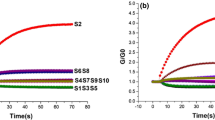Abstract
Multivariate data analysis methods play a key role in extracting effective features to denote original tea samples. The most commonly used multivariate data analysis methods are principle component analysis and linear discriminant analysis. These methods are based on statistical learning theory and complete in mathematics. However, there is correlation and redundancy among multiple sensors of electronic tongue, and it cannot guarantee that the tea samples are linearly separable in the original data space. The aim of this study is to conduct new dimensionality reduction methods: manifold learning algorithms, to extract effective features from the responses of electronic tongue sensors, and the algorithm which gives the highest recognition accuracy is considered to be the best for tea quality gradation. Experimental results show that supervised nonlinear manifold learning algorithms outperform other methods and achieve the highest recognition accuracy for green tea with four quality grades.









Similar content being viewed by others
References
Banerjee B (1993) Tea production and processing. New Delhi, India
Liang Y, Lu J, Zhang L, Wu S, Wu Y (2003) Estimation of black ea quality by analysis of chemical composition and color difference of tea infusions. Food Chem 80:283–290
Dutta R, Hines EL, Gardner JW, Kashwan KR, Bhuyan M (2003) Tea quality prediction using a tin oxide-based electronic nose: an artificial intelligence approach. Sens Actuators B 94:228–237
Pelillo M, Biguzzi B, Bendini A, Toschi TG, Vanzini M, Lercker G (2002) Preliminary investigation into development of HPLC with UV and MS-electrospray detection for the analysis of tea catechins. Food Chem 78:369–374
Zou YG, Chen H, Deng YW (2002) Simultaneous determination of catechins, caffeine and gallic acids in greddn, oolong, black and pu-erh teas using HPLC with a photodiode array detector. Talanta 57:307–316
Togari N, Kobayashi A, Aishima T (1995) Pattern recognition applied to gas chromatographic profiles of volatile component in three tea categories. Food Res Int 28:495–502
Wang L, Lee J, Chung J, Baik J, Park S (2008) Discrimination of teas with different degrees of fermentation by SPME-GC analysis of the characteristic volatile flavour compounds. Food Chem 109:196–206
Horie H, Mukai T, Kohata K (1997) Simultaneous determination of qualitatively important components in green tea infusions using capillary electrophoresis. J Chromatogr A 758:332–335
Herrador MA, Gonzalez AG (2001) Pattern recognition procedures for differentiation of green, black and oolong teas according to their metal content from inductively coupled plasma atomic emission spectrometry. Talanta 53:1249–1257
He W, Hu X, Zhao L, Liao X, Zhang Y, Zhang M, Wu J (2009) Evaluation of Chinese tea by the electronic tongue: correlation with sensory properties and classification according to geographical origin and grade level. Food Res Int 42:1462–1467
Lvova L, Legin A, Vlasov A, Cha Y, Nam GS (2003) Multicomponent analysis of Korean green tea by means of disposable all-solid-state potentiometric electronic tongue microsystem. Sens Actuators B 95:391–399
Liao J, Andi SO (2005) Sensory quality examination for Taiwan oolong tea by sensory analysis and electronic tongue, International Tea Symposium, Section 7. Chemistry F9:665–673
Wu J, Liu J, Fu M (2006) Classification of Chinese green tea by a voltammetric electronic tongue. Chin J Sens Actuators 19:963–965
Chen Q, Zhao J, Vittayapadung S (2008) Identification of the green tea grade level using electronic tongue and pattern recognition. Food Res Int 41:500–504
Xiao H, Wang J (2009) Discrimination of Xihulongjing tea grade using an electronic tongue. Afr J Biotechnol 8:6985–6992
Palit M, Tudu B, Bhattacharyya N, Dutta A, Dutta PK, Jana A, Bandyopadhyay R, Chatterjee A (2010) Comparison of multivariate preprocessing techniques as applied to electronic tongue based pattern classification for black tea. Anal Chim Acta 675:8–15
Breijo EG, Atkinson J, Sanchez LG, Masot R, Ibanez J, Garrigues J, Glanc M, Miro NL, Olguin C (2011) A comparison study of pattern recognition algorithms implemented on a microcontroller for use in an electronic tongue for monitoring drinking waters. Sens Actuators A 172:570–582
Xu Y, Chen W, Yin B, Huang L (2004) Green storage and preservation. Agric Mach Technol Ext 9:29–32
Scampicchio M, Benedetti S, Brunetti B, Mannino S (2006) Amperometric electronic tongue for the evaluation of the tea astringency. Electroanalysis 18:1643–1648
Belhumeur PN, Hespanha JP, Kriegman DJ (1997) Eigenfaces vs. Fisherfaces: recognition using class specific linear projection. IEEE Trans Pattern Anal Mach Intell 19:711–720
He X, Niyogi P (2003) Locality preserving projections. In: Proceedings of Conference Advances in Neural Information Processing Systems
Liu Q, Jin H, Tang X, Lu H, Ma S (2008) A new extension of kernel feature and its application for visual recognition. Neurocomputing 71:1850–1856
Tenenbaum JB, Silva V, Langford JC (2000) A global geometric framework for nonlinear dimensionality Reduction. Science 290:2319–2323
Roweis ST, Saul LK (2000) Nonlinear dimensionality reduction by locally linear embedding. Science 290:2323–2326
Zhi R, Ruan Q (2010) Facial expression recognition using fuzzy Laplacianfaces. Int J Innov Comput I(6):1999–2011
Acknowledgments
This work is supported by China National High Technology Research and Development Program 863 (No. 2011AA1008047) and the National Natural Science Foundation of China (No. 31201358).
Conflict of interest
None.
Compliance with Ethics Requirements
This article does not contain any studies with human or animal subjects.
Author information
Authors and Affiliations
Corresponding author
Rights and permissions
About this article
Cite this article
Zhi, R., Zhao, L., Shi, B. et al. New dimensionality reduction model (manifold learning) coupled with electronic tongue for green tea grade identification. Eur Food Res Technol 239, 157–167 (2014). https://doi.org/10.1007/s00217-014-2205-0
Received:
Revised:
Accepted:
Published:
Issue Date:
DOI: https://doi.org/10.1007/s00217-014-2205-0




